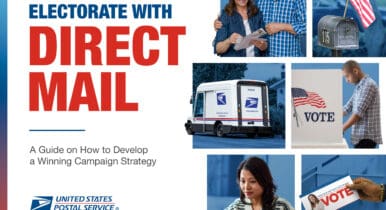Making the Most Out of Campaign Mail Design


This past election season, many campaigns were forced to explore unique ways to connect with voters and drive home messages that would resonate with their constituency.
In particular, the use of creative tactics, like QR codes®, reinforce how mail innovation was key in 2020 as direct mail became the most tangible and tactile connection many voters had with the candidates and issues in their districts. Campaigns saw QR codes showing up everywhere, including restaurant menus, and started leveraging that by integrating them more widely into direct mail pieces to drive voters to take action by visiting campaign websites, fundraising pages, and dual-language videos to inform on the absentee ballot voting process.
At the United States Postal Service, we wanted to gain a greater understanding of what made direct mail campaigns effective, including design, and identify which innovative tactics from the 2020 election cycle can be applied to future campaigns. We conducted post-election research that included surveys, focus groups, and in-depth interviews with Americans of all stars and stripes as well as mail consultants and other campaign experts. Here’s what they said:
Creativity matters
As campaigns worked to educate and motivate voters, they designed their mail pieces to maximize connection and impact. In addition to QR codes, unique die-cut pieces were used to break up copy and invoke excitement. There was innovation in photography and some used eye-catching infographics. Many campaigns found a use for volunteers creating hand-designed, personalized postcards for fellow voters. Scratch-off or coloring-book mail added an additional layer of reader engagement. Many campaigns found mail design inspiration beyond campaign mail, drawing from business mail and even magazines. Overall, these tactics seemed to work as half of Americans surveyed said that mail was the most memorable form of political advertising they saw in the recent election.
Strive for personal connection
According to our research, many Americans said they take note of bold font, bright colors, paper quality, paper size, and eye-catching photographs. These attributes are what persuade them to take a second look. Breakthrough mail doesn’t rely on cookie cutter designs but utilizes strong imagery that tells a story or reinforces campaign messages. One focus-group participant said, “If they could have pictures with their family and their kids, that would definitely strike a chord with me because I’m married and I have kids and it’s like, okay. You’re just one of us.”
Consider the call to action
About half of Americans surveyed (48%) say the mail they received drove them to search online for more information about a political campaign. Research participants indicated they were very likely to use mail as a starting point before turning to the internet or social media for more information. This tells us that having a clear call to action is important, whether it is to a campaign website, video, or social channels. Also, campaigns should consider using high performing keywords from their website on their mail pieces, so voters who are searching for more information about a specific candidate will be able to find relevant information there.
Authenticity is key for diverse voters
Americans noted that the mail they receive needs to be designed in a way that feels relevant, localized, and personal. It’s important to note that diverse audiences have a stronger degree of trust in mail, particularly when it is done well. A majority of both Hispanic Americans (64%) and African Americans (57%) trust direct mail more than political ads on TV. However, authenticity is key. One participant commented, “Even though I do speak Spanish and I am bilingual, I want to know that you care about what we think, but not in a performative way, in an authentic way. If it’s performative, I don’t care. I don’t want to hear it.”
Embrace of dual language mail
Many campaigns designed mail to communicate with voters in multiple languages, particularly to inform on the intricacies of voting from home. This approach resonated with voters, with one participant noting, “For me it is engaging, because it means to me that the candidate or the party made an effort to try to reach out to me.”
We are excited to release additional insights from our post-election research in the months ahead. The Postal Service is committed to helping campaigns win the trust of voters and inspire them to vote. Whether it is direct mail insights, consulting on direct mail design, or navigating operational support, the Postal Service is committed to helping campaigns Deliver The Win®. If you would like to talk to a direct mail specialist, please contact us directly or visit www.deliverthewin.com.
*Statistics are sourced from research conducted on behalf of the Postal Service by Summit Research and KRC Research from November 2020 through February 2021. The research includes post-election voter surveys and focus groups as well as insights from a political consultant survey and in-depth interviews.
Donald Nichols has worked for the United States Postal Service for over 25 years and is currently serving as the National Lead for USPS® Political Mail Outreach efforts. In this role, Donald mobilizes a national team of specialists who consult with and support political campaigns, campaign strategists and political alliance mailing partners. He also manages strategic sponsorships for USPS® with political associations to raise awareness and coordinates marketing and sales efforts to support the use of political mail. Together, Donald and his team help clients identify winning media combinations to Deliver the Win® for their campaigns.
Contact Donald at Donald.R.Nichols@usps.gov and follow him at LinkedIn


